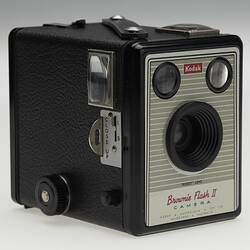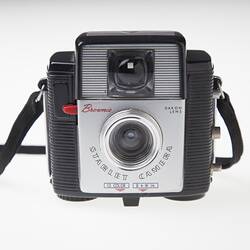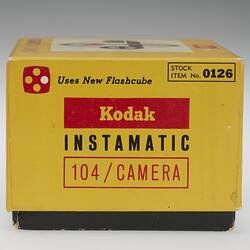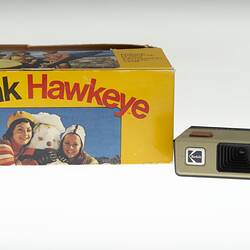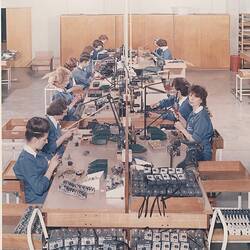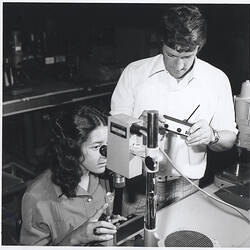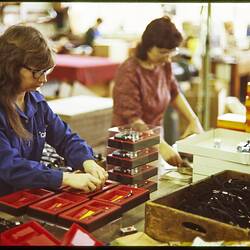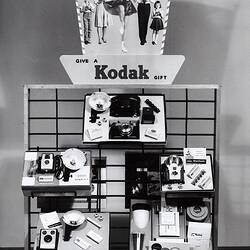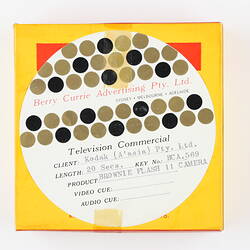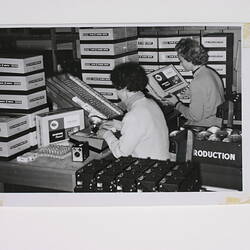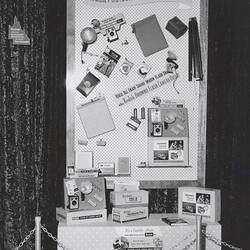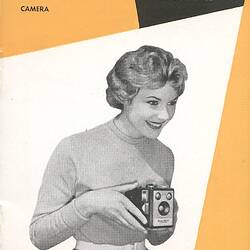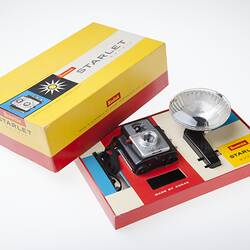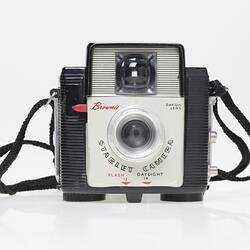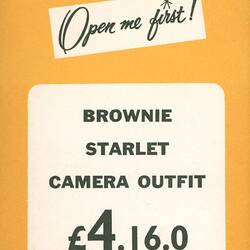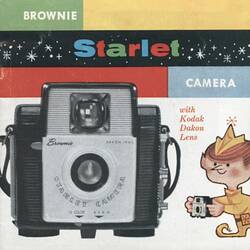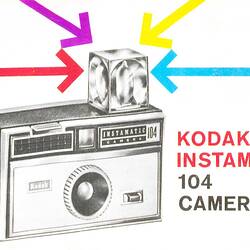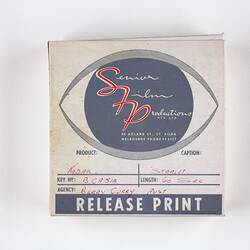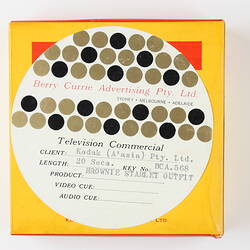Australasia began assembling cameras in Australia at the company's Abbotsford factory in 1957. The first camera to be assembled locally was the Kodak Brownie Flash II. This model camera was originally designed and built by Kodak Limited, England, and the parts for Australian assembled products were imported from England.
From 1958 an increasing range of components was made locally, and soon the Brownie Flash II was replaced by the Brownie Star series of cameras, which were assembled from more than 95% Australian parts. The Star series products were the first low-priced cameras "designed to take color slides, as well as color and black-and-white snapshots". There were three camera models in the Star series, and ten million of them were sold around the world in five years. The first Star series product locally assembled was the Brownie Starlet camera, which was originally created by Eastman Kodak in the USA in the late 1950s. This was followed by the Brownie Starmite and then the Brownie Starflash, the latter being the first Kodak camera with a built-in flash holder.
In 1963 Kodak Australasia began production of lnstamatic cameras in the Camera, Reels & Sundries Department in Building 15 at the company's new factory in Coburg. The small and compact Instamatics had a huge impact on amateur photography, as they were inexpensive, easy to use and loading the camera with film was fast and easy - users only had to drop a film cartridge (126 format) into the back of the camera. The camera came with flash for indoor and night photography, and it took colour and black & white print film as well as colour slide film. The first Instamatics to be assembled locally in Australia were models 50, 100 and 104. By 1970, 50 million Instamatics had been made worldwide.
In early 1974, Kodak Pocket Instamatic cameras went into production at Coburg, over a year after the range was released internationally. The range was produced with a team of 25 staff assembling the 100, 200 and 300 models of the Pocket Instamatic cameras, which were distributed to the Australian and New Zealand markets. The cameras were made largely from parts imported from Kodak Limited in England, however a couple of components were made locally, requiring a new plastic injection moulding system to be set up. The assembly of Pocket Instamatics was complex and extensive, and before setting up the assembly line at Coburg, project engineer Stan Keleher travelled to England to study the assembly process. Various improvements were implemented for the Australian model. Once in full production, several hundred cameras a day were made at the factory. In 1977 the Pocket Instamatic model 92 began production.
The X-Series Instamatic models also began to be assembled at Coburg in 1977, including 56-X, 76-X, 177-X and 277. In August of 1977 the 4 millionth Kodak camera was assembled by the Kodak Australasia camera assembly team. The assembly staff were mainly women, and in the 1970s at Coburg they included Ann Orr, one of the first women to have started in the department back at Abbotsford, camera assembler Joy Nyssen, and packaging staff Eileen Warner, Olive Joseph, Maureen Wolf and Lily Hodges, as well as others. Managers were generally all men and some of them were Wally Lawrence, who was manager of Camera, Reels and Sundries in the late 1970s, project engineer Stan Keleher, Jack Kinsman who was in charge of camera assembly, and Bert Leusenkamp, a leading hand, the latter two who had been involved in camera assembly almost since the beginning of Australian production. As well as its own assembly, packaging and supervisory staff, the Camera, Reel and Sundries Department relied heavily on the Engineering Department. Camera production required special quality control equipment and very intricate tooling to give the quality and speed of production required, and so the camera production section was supported by skilled engineers, toolmakers and fitters throughout its history. By circa 1981 camera manufacture and assembly in Australia had stopped, as it was not financially viable there compared to Kodak's international manufacturing plants, and competition from Japanese made cameras had started to put a squeeze on profits for Kodak globally. However, in the twenty-four years that the Camera, Reel and Sundries Department was assembling and making cameras at the Abbotsford and Coburg factories, it had successfully produced over four million cameras for customers in the Australasia region.
References
Australian Kodakery, No. 17, Mar-Apr 1970, p.1.
Kodak Sales News, Mar-Apr 1971.
Kodak Sales News, Nov 1972.
Australian Kodakery, No 41, Dec 1972.
Kodak Sales News, Mar 1973.
Australian Kodakery, No. 50, Feb / March 1974, p.5.
Australian Kodakery, No. 82, September 1977, pps. 1, 3.
Kodakery, No. 168, March, 1985, p.5.
https://www.brownie-camera.com/22b.shtml
Kodak Heritage Collection Volunteer Team, composed of former Kodak engineering department and related staff, who documented key points in Kodak's camera production history.
More Information
-
Keywords
-
Authors
-
Article types

